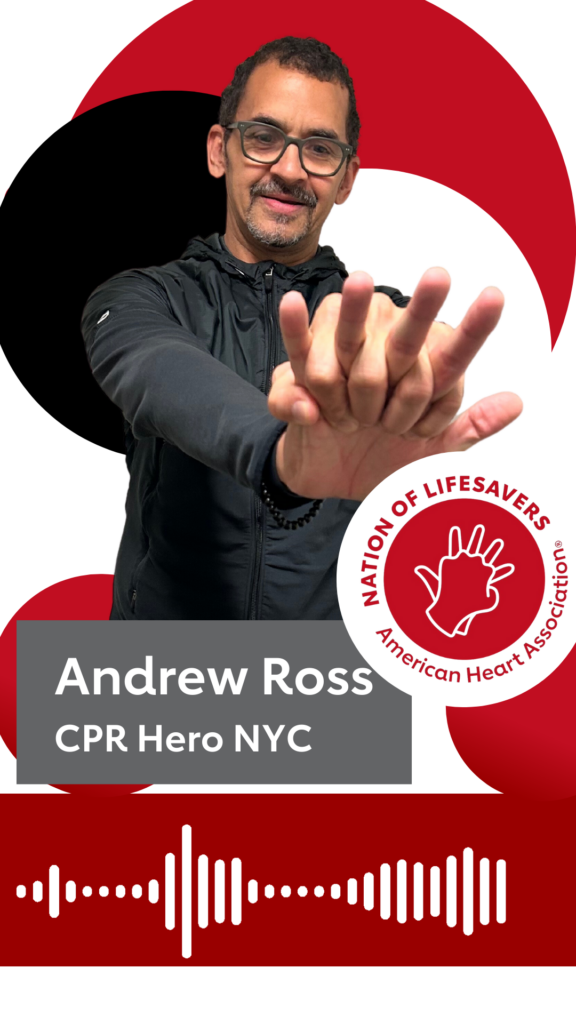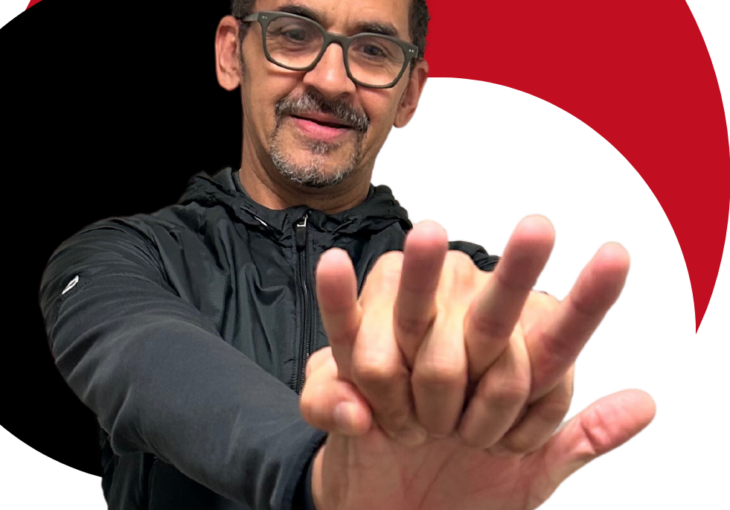By Diego Ortiz Quintero
 Tap the play button above to listen to an audio recording of this article.
Tap the play button above to listen to an audio recording of this article.
This Monday, October 16th is World Restart A Heart Day, a global initiative to increase awareness about the importance of bystander cardiopulmonary resuscitation (CPR) and to also increase actual bystander CPR rates worldwide by educating the public about learning Hands-Only CPR. The American Heart Association in New York City would like to mark this occasion by honoring a local CPR Hero named Andrew Ross, who saved two people by performing CPR on the same day in August of this year while on his lunchbreak in the Greenwich Village section of New York City.
“I watched in shock as the first person went into cardiac arrest. I jumped into action. I began chest compressions, and as the adrenaline surged through my veins, I was able to revive him,” Ross said.
But the drama didn’t stop there. Moments later he heard more screams – two more people were in cardiac arrest.
“I ran to the scene, and once again, I began the life-saving process of CPR. With grit and determination, we brought the second person back from the brink as well. And soon the paramedics arrived and they revived the third victim,” Ross says.
Ross, who has been working in the field of mental health and substance use disorder in New York City for 30 years, believes this cardiac arrest cluster was the result of drug overdoses. He says the victims initially received naloxone, an opioid antagonist medication that is used to reverse an opioid overdose and block the effects of opioids, such as heroin, morphine, and oxycodone and they did not respond.
Though there is no toxicology report to confirm definitively what substances if any, contributed to these cardiac arrests, two factors –- the fact the victims did not respond to naloxone and the chatter among individuals suffering with substance use disorder on the street that morning — lead Ross to believe the likely culprit was a dangerous concoction of opioids and xylazine. Xylazine is a veterinary sedative that the has been recorded in previous reports by the New York City Department of Health and Mental Hygiene in drug samples that also contain fentanyl.
According to the New York City Department of Health and Mental Hygiene, in 2021, 19% of opioid-involved overdose deaths in NYC also involved xylazine. Two thousand six hundred and sixty-eight (2,668) individuals died of a drug overdose in New York City in 2021, an increase of 78 percent since 2019 and 27 percent since 2020, with evident disparities by age, race, poverty level, and neighborhood of residence.
Fentanyl—an opioid 50 to 100 times stronger than morphine—was detected in 80% of drug overdose deaths in New York City in 2021 and was the most common substance involved in overdose deaths for the fifth year in a row.
A non-opioid, xylazine is a central nervous system depressant that can increase the risk of overdose due to its deeply sedating effect. Since xylazine is not an opioid, naloxone does not work to reverse its effects. However, since xylazine is nearly always found in conjunction with opioids, medical experts agree that suspected overdoses should be treated with naloxone.
Do you know how to respond to a person who has potentially overdosed on opioids?
 The American Heart Association recommendation calls for laypeople and others who cannot reliably establish the presence of a pulse to initiate cardiopulmonary resuscitation (CPR) in any individual who is unconscious and not breathing normally. If opioid overdose is suspected, naloxone should also be administered.
The American Heart Association recommendation calls for laypeople and others who cannot reliably establish the presence of a pulse to initiate cardiopulmonary resuscitation (CPR) in any individual who is unconscious and not breathing normally. If opioid overdose is suspected, naloxone should also be administered.
According to the American Heart Association, widespread community training in cardiopulmonary resuscitation (CPR) and naloxone administration is of growing importance.
“Opioids kill more Americans than all other poisons together by a lot,” says Dr. Eric Lavonas, professor of emergency medicine at Denver Health and the Rocky Mountain Poison and Drug Center, who led an expert panel that wrote the American Heart Association’s latest updated guidelines, published in September in the journal Circulation. “They kill more Americans than motor vehicles, and the death rate keeps climbing. It’s getting insane.”
The guidelines address opioids, poison and substances that cause cardiac arrest when the heart suddenly stops beating.
Andrew Ross’ CPR motivation
Andrew Ross has carried a tremendous weight with him for many years.
“I watched my friend, a young woman named Janet, go into cardiac arrest and helplessly stood by as she took her last breaths,” Ross says. “For years, I held myself accountable until I decided to do something about it. I started my journey to learn CPR, and eventually became an instructor to teach others. I promised myself that if anything like what I had experienced were to happen again, I would be ready this time.”
This time Ross was ready, and the American Heart Association looks forward to honoring his bravery in saving not one but two people experiencing cardiac arrest.
“Now, I can’t say with certainty whether those individuals would be alive today if I hadn’t taken immediate action. But what I can say is that we were fortunate enough to save them that day,” Ross said.
When a person has a cardiac arrest, survival depends on immediately receiving CPR from someone nearby. According to the American Heart Association, about 90 percent of people who suffer out-of-hospital cardiac arrests die.
CPR, especially if performed immediately, can double or triple a cardiac arrest victim’s chance of survival.
Ross wants to encourage more New Yorkers to learn CPR.
“I want to help people be ready so that when they find themselves on the scene, they won’t stand helplessly by – they’ll leap into action armed with the tools and knowledge to save a life,” Ross said.
Please visit cpr.heart.org to watch an American Heart Association video that provides a basic understanding of the opioid epidemic and how to recognize and respond to a person who has potentially overdosed on opioids.
https://cpr.heart.org/en/courses/opioid-education
Watch this short interview with Andrew Ross
